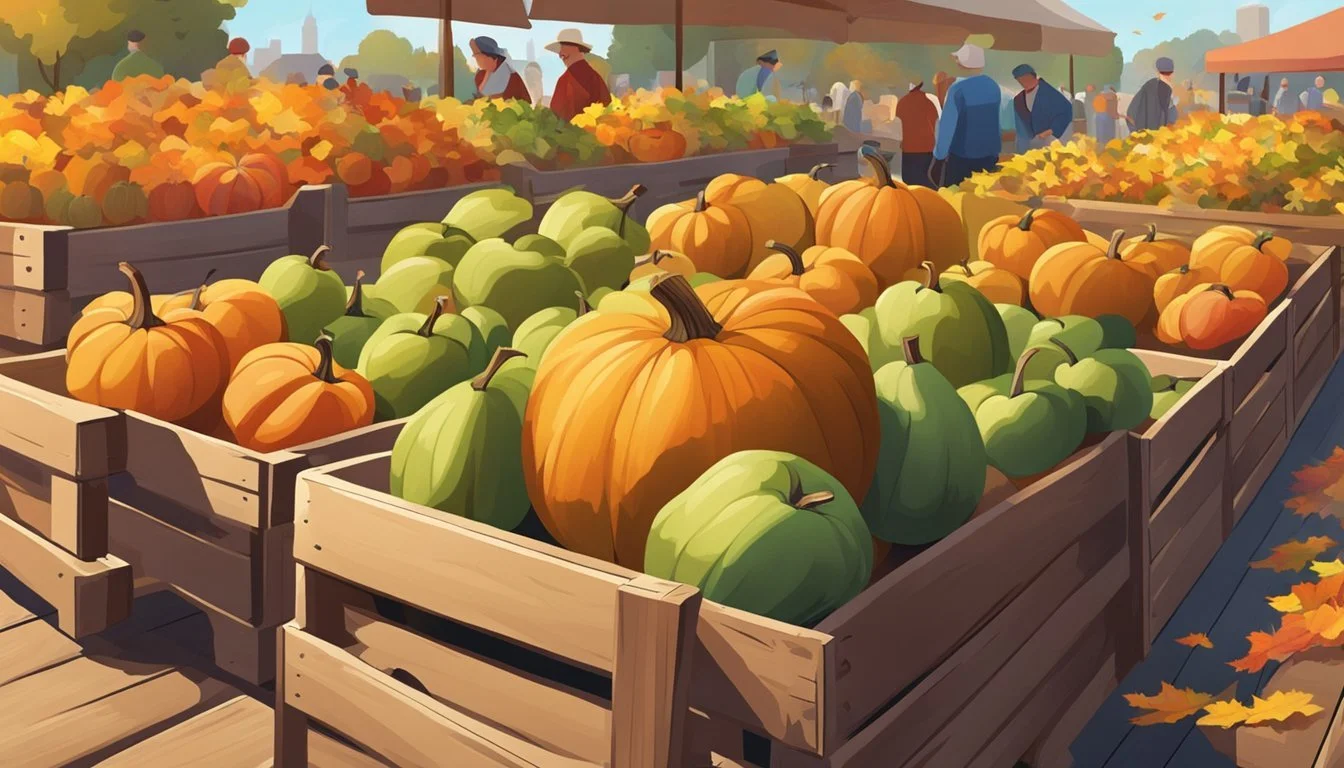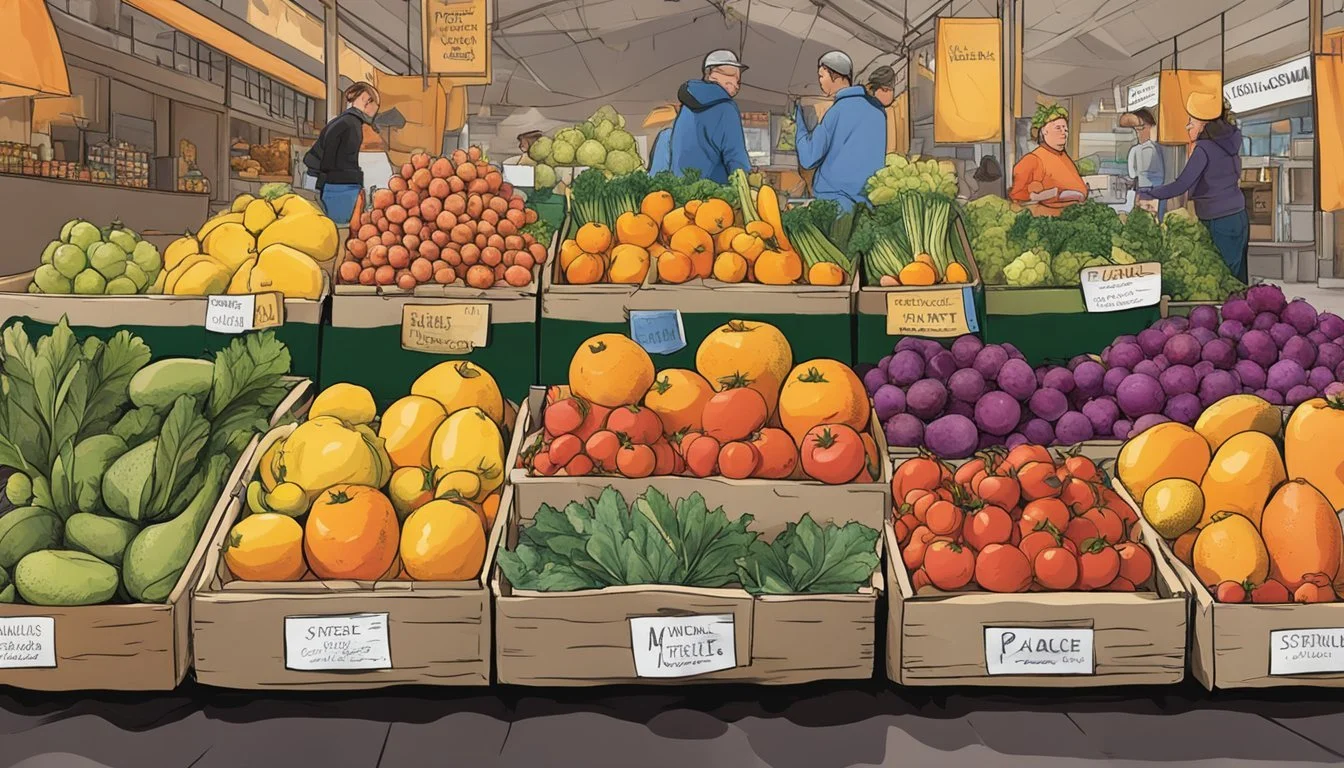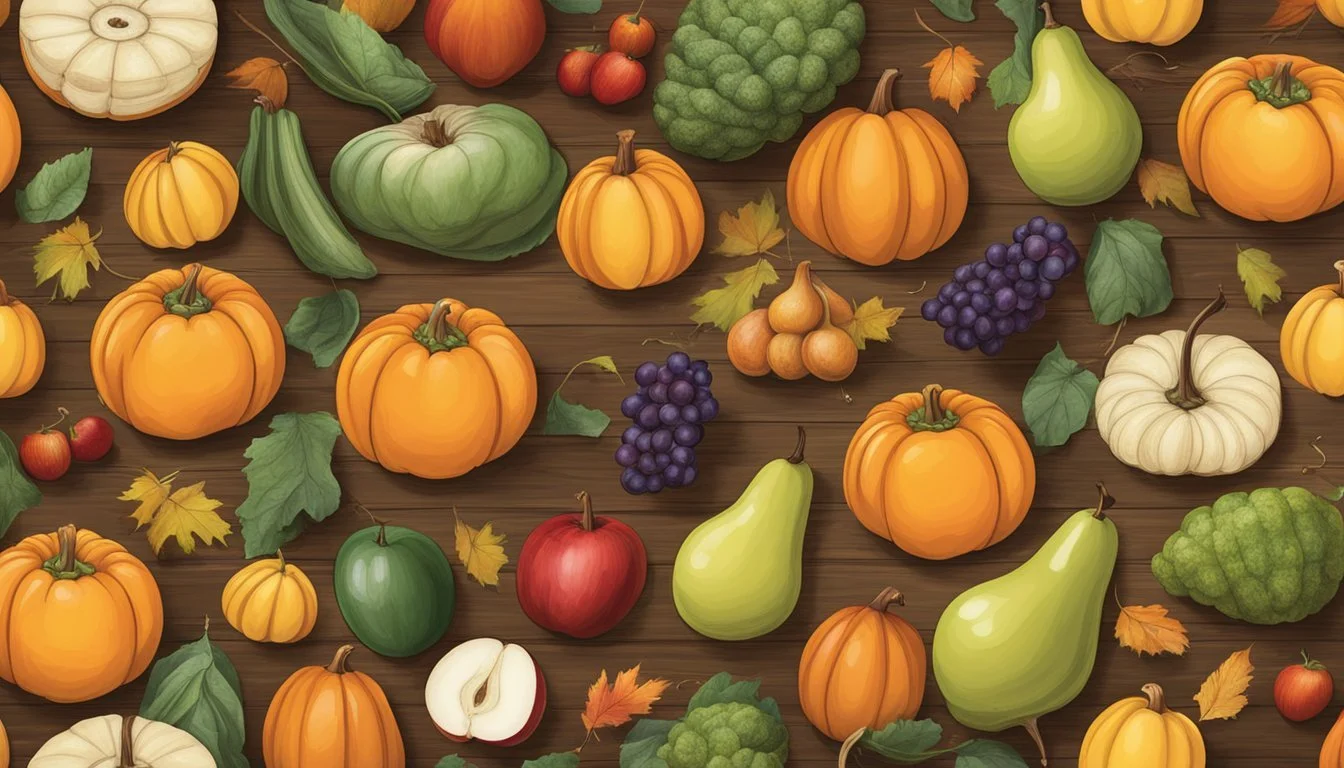Utah Seasonal Fruit & Vegetables in November
Your Guide to Fresh Produce
This Article is Part of our Utah Seasonal Fruit & Veg Calendar
In the heart of the American West, Utah's distinct seasons present a diverse tapestry of fruits and vegetables that change as the calendar flips through the months. November in Utah is a time when the autumnal chill has settled in, paving the way for a unique harvest of produce that thrives in cooler temperatures. This transition period sees a notable shift in the agricultural offerings as the state's farmers markets and produce aisles adapt to the seasonal change.
The state's agricultural output during November leans heavily on late-season crops that can endure the dropping temperatures. Hardy vegetables like cabbage, carrots, and cauliflower become staples, their growth uninhibited by the cooler weather. Meanwhile, fruits such as apples reach their peak, providing a sweet contrast to the earthiness of late autumn vegetables. Root vegetables and squashes, which are harvested in late fall, also become abundantly available, offering a rich variety of options for hearty meals and holiday cooking.
Utah's embrace of its seasonal produce is a testament to its agricultural ingenuity and the adaptability of its farming practices. Consumers benefit from this seasonal abundance through access to fresh, locally-grown produce that supports not only a healthier lifestyle but also the local economy. As winter approaches, the November harvest in Utah showcases the bountiful finale of the growing season.
Overview of Utah's Seasonal Produce
Utah's seasonal produce in November offers a varied selection of fruits and vegetables transitioning between autumn harvests and the onset of cooler temperatures, reflecting a period of hearty produce and the tail end of fall specialties.
Understanding Seasonal Eating in Utah
In November, Utah transitions from the vibrant offerings of fall into the heartier selections typical of early winter. Seasonal eating in Utah involves consuming fruits and vegetables that are harvested at their peak of ripeness during this month, providing a combination of both flavor and nutrition. During this time, locals may witness the last of certain crops while others are just reaching their prime harvesting period.
Fruits typical in November: Late-season apples and pears.
Vegetables typical in November: Winter squash, potatoes, carrots, and onions.
Benefits of Consuming November Produce
Eating seasonally in November in Utah not only supports local farmers but also ensures that consumers receive produce packed with optimal freshness and nutritional value. Additionally, seasonal produce tends to have a lower carbon footprint due to reduced transportation and storage requirements.
Nutritional value: Vegetables like carrots and squash provide beta-carotene, essential for immune health during the colder months.
Environmental impact: Local, in-season produce reduces the need for long-distance food transport, thus minimizing greenhouse gas emissions associated with travel.
Fruits Available in November
In November, consumers in Utah can enjoy a variety of fresh fruits, including robust citrus fruits and pome varieties as well as a selection of less common fruits that thrive in the cooler climate.
Citrus Fruits and Pome Varieties
Citrus fruits begin to make their appearance in November. While not as abundant as in peak citrus season, they offer a fresh zest of flavor. In terms of pome fruits, apples and pears are readily available and can be found in numerous varieties, satisfying a range of tastes and culinary uses.
Apples: A staple in Utah, varieties such as Fuji, Gala, and Granny Smith are commonly harvested in fall and remain crisp and flavorful through cold storage.
Pears: Varieties like Bartlett and Anjou pears are often harvested just before November, retaining their juicy texture and sweetness well into the month.
Less Common Fruit Selections
Beyond the more common apples and pears, Utah's November produce includes fruits that are less frequently encountered. These fruits often have shorter seasons but are highly anticipated for their unique flavors.
Persimmons: Known for their bright color and sweet, honey-like flavor, they are typically at their peak in November.
Pomegranates: With jewel-like seeds, pomegranates are both nutritious and flavorful, offering a tart taste and crunchy texture.
In addition to these, cranberries may also be available, often associated with holiday dishes and known for their tart, vibrant flavor. While these fruits are less common, they add diversity to the fruit selection and culinary possibilities during this time.
Vegetables to Enjoy in November
As November arrives in Utah, a bountiful selection of vegetables reaches peak season, providing rich flavors and essential nutrients. This time of year is especially good for root vegetables and squashes, as well as leafy greens and brassicas.
Root Vegetables and Squashes
Root vegetables thrive in the cooler temperatures of a Utah November. Starchy staples like potatoes and sweet potatoes are abundant, offering versatility in cooking, from roasting to mashing. Beets and carrots, known for their deep colors and sweet flavors, are ideal for adding a nutritious punch to meals. Additionally, winter squash and pumpkins are in ample supply, perfect for hearty soups and pies. November is also a time to enjoy onions and turnips, which can be roasted to enhance their natural sweetness or used to build flavor in stews and broths.
Squash: Acorn, butternut, spaghetti, and more
Onions and Garlic: Essential for flavor
Potatoes: Red, gold, and sweet varieties
Leafy Greens and Brassicas
The chill of November brings out the best in leafy greens and brassicas. Kale, (What wine goes well with kale?) with its robust leaves, stands up well to frost, becoming even sweeter after a cold snap. Brussels sprouts and broccoli are at their peak, offering crispy textures and flavors that pair well with roasts and grain dishes. Cabbage and chard are also plentiful, adding crunch and color to salads and sautés. These greens are not only flavorful but also packed with vitamins and fiber.
Kale: Curly and Lacinato (dinosaur) varieties
Brussels sprouts: Great for roasting
Cabbage: Green and purple varieties
Greens: Including mustard greens and collard greens (how long do collard greens last?)
By incorporating these seasonal vegetables into one's diet, Utahn's can enjoy fresh, local produce that is both delicious and supportive of local agriculture.
Herbs and Other Produce
In Utah's November harvest, the range of herbs and other produce available adds depth and aroma to the seasonal palette. These items are essential for culinary enthusiasts looking to incorporate fresh, local flavors into their autumnal recipes.
Aromatic Additions
Sage: A quintessential herb for November, sage is at its peak in Utah. Its earthy and slightly peppery flavor makes it an indispensable addition to Thanksgiving dishes, particularly in seasoning poultry and stuffing.
Garlic: Robust and pungent, garlic harvested in November imparts a foundational flavor to a multitude of hearty fall dishes. It stores well, allowing consumers to enjoy its taste well beyond the harvest season.
Year-Round Staples
Even as the autumn chill sets in, some produce remains a constant in Utah’s agricultural offerings:
Herbs: A variety of herbs continue to thrive in November. While not all are at the height of their season, many such as rosemary and thyme can still be sourced locally, providing fresh flavors for seasonal cooking.
Mushrooms: They are not bound by the same seasonal constraints as plants, making them a valuable component of the year-round produce selection in Utah. Their earthy tones enhance the savory notes of November's meals.
Navigating Farmers Markets and Stores
When shopping for fresh produce in Utah during November, one can find a variety of fruits and vegetables that are in season. Being strategic in where and how to shop can enhance the quality and taste of your meals.
Finding Fresh Produce
At Utah farmers markets in November, one should look for hearty vegetables that thrive in cooler weather. Here's a list of fresh produce typically available at this time:
Root Vegetables: carrots, beets, and turnips
Leafy Greens: kale and spinach
Winter Squash: butternut, acorn, and spaghetti squash
Apples: a variety of late-harvest apples
Farmers markets are ideal for sourcing these items as they are likely to have the freshest stock, often harvested within days of the market.
Selecting and Storing Tips
To ensure one gets the best produce at farmers markets or stores, consider the following:
Firmness and Color: Vegetables should be firm to the touch with vibrant colors.
Smell: Fresh produce often has a distinct, pleasant smell.
Storage: Keep root vegetables in a cool, dark place, and refrigerate leafy greens in a moisture-proof container.
Apples come in many varieties, so ask vendors for samples or advice on the best types for eating fresh or for cooking. Store apples in a cool, slightly humid environment like a refrigerator crisper drawer.
Preparation and Recipe Ideas
In November, Utah's harvest offers a bounty that can be transformed into warming meals and wholesome sides. Utilizing seasonal produce, one can craft dishes that are not only flavorful but also nutritionally rich.
Hearty Winter Meals
Sunchoke Soup: Sunchokes, also known as Jerusalem artichokes (What wine goes well with artichokes?), make for a velvety and earthy soup base. They can be simmered with garlic, onions, and stock until tender, then pureed until smooth. A swirl of cream and a sprinkle of crispy bacon (how long does bacon last?) bring a satisfying finish to this comforting dish.
Salsa with Roasted Vegetables: A smoky salsa can be created by roasting November vegetables such as onions and chilies. Blended with tomatoes, cilantro, and a squeeze of lime, this salsa serves as a dynamic accompaniment to grilled meats or a bold topper for a hearty salad.
Healthy Snacks and Sides
Kale and Apple Salad: Kale is resilient throughout the colder months and pairs exceptionally well with seasonal apples. Tossed in a light vinaigrette and topped with nuts for crunch, this salad is both refreshing and substantial.
Roasted Sunchokes: When roasted, sunchokes develop a crispy exterior and a tender, flavorful interior. They can be tossed with a bit of olive oil and sea salt (how long does sea salt last?), making an excellent side dish or a healthy snack option.
Bacon-Wrapped Asparagus (how long does asparagus last?): Fresh asparagus spears wrapped in bacon and roasted until the bacon is crisp is a simple yet delicious side that combines the richness of bacon with the natural goodness of seasonal vegetables.
Sustainability and Local Agriculture
In Utah, the emphasis on sustainability through local agriculture strengthens the community and supports the state's economy. Residents can make a profound impact by choosing to eat seasonally.
Supporting Utah Farmers
Supporting local farmers is crucial for the sustainability of agriculture in Utah. When residents purchase fruits and vegetables directly from local growers, especially during the growing season, they help to ensure that farmers can continue to operate profitably. Here are key benefits:
Economic Stability: Money spent on local produce stays within the state, fostering financial security for farm families.
Community Health: Local agriculture promotes the availability of fresh, nutritious produce, which in turn contributes to the community's well-being.
The Impact of Seasonal Eating
Seasonal eating in Utah aligns consumers with the natural growing season, which can significantly reduce the environmental impact associated with food transport and storage. Specific impacts include:
Reduced Carbon Footprint: Eating fruits and vegetables that are in season locally reduces the demand for out-of-season produce, which must be shipped from other regions or countries.
Better Taste and Nutrition: Seasonally available produce is often fresher, tastier, and more nutritious than food grown out of season and shipped over long distances.
By focusing on sustainability and local agriculture, Utahns play an active role in preserving their state's diverse agricultural heritage and contributing to a healthier environment.









